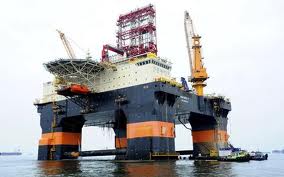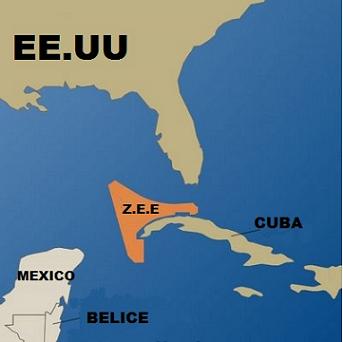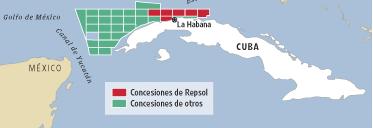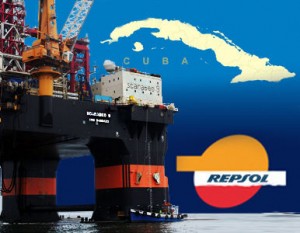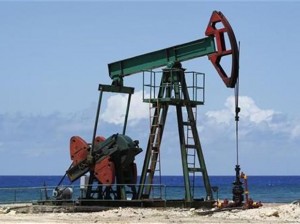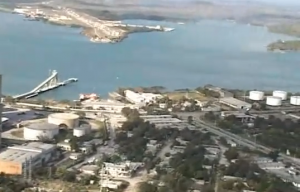The oil exploration rig Scarabeo 9 is finally positioned in Cuban waters and this week will start digging deep into a block of the Exclusive Economic Zone (EEZ).
He seemed distant and questionable choice of drilling in the deepwater Gulf of Mexico near Cuba. But the day has come and now the expectations are set not only the possibility of drilling in the discovery of crude that could change the destiny of the Caribbean country.
The platform arrived off the Malecon in Havana on Thursday, precisely at a time when the influential senator in December Durbin, Democrat of Illinois and number two in the upper house in Congress, visited the island with a book little known. A brief note of your accounts oficiana gave Durbin’s visit to discuss oil and contractor Alan P. Gross, Cuba sentenced to 15 years in prison.
Oil and Gross, two fundamental issues in the bilateral relationship and the future of Havana-Washington dispute. Despite the discord and yet it would be irrational for grans U.S. oil companies to stay out of the pie that would be offered in its own backyard.
The truth is that Durbin’s visit set the tone of a trend that we see in the coming weeks or months as the drilling of the Scarabeo 9 show promising results for oil development in the medium and long term.
The consortium Repsol YPF shares breaks this week in pursuit of the coveted discovery. Cuban Oil Week is underway.
CaféFuerte answered here a round of key questions about oil drilling that soon will make history in Cuba.
What is Scarabeo 9 ?
A next-generation semi-submersible platform, built in Chinese shipyards at a cost of $ 750 million. The team finished manufactured middle of last year in Shanghai by the firm Saipem, on behalf of the Italian company Eni SpA’s, based in Milan and owns 43 percent of the shares in the company china. The construction of the tax was to ensure that contractors were not used more than 10 percent of U.S. components not to violate the embargo law. In August, the self-propelled platform, 380 feet long, began to move from Singapore, where he was appointed, to the Gulf of Mexico after shutdowns in South Africa, Brazil and Trinidad Tobago.
When begin drilling ?
It’s a matter of hours. The Scarabeo 9 due to start operating between Monday and Tuesday. Repsol has every interest in not wasting time, due to the high cost of equipment operations.
Where is drilled ?
In block Jaguey, leased by Repsol. The block is located 22 miles off the Cuban coast, at the height of the beach of Santa Fe Repsol made the first exploratory tests in 2004.
How deep will be drilled ?
At 1.700 meters deep. Although the team is able to explore more than 3,600 meters.
What staff will be working on the platform ?
The staff includes highly skilled technicians, of various nationalities. The platform has the capacity to house 200 employees. Board will work in shifts of 15 days.
What is the cost of the operation ?
Repsol pays a daily rental of $ 511.000 dollars, so that the costs in a month around $ 15 million.
How many blocks Repsol has contracted for oil exploration in Cuba ?
Six in total. Repsol-YPF leases about 4,500 square miles of Cuba’s Exclusive Economic Zone (EEZ), shared with the consortium Norwegian Statoil-Hydro (30%) and India’s ONGC (30%).
What is Cuba’s EEZ ?
The Gulf of Mexico EEZ is delimited by the maritime borders with Mexico and the United States, and covers an area of 112.000 square kilometers, divided into 59 exploration blocks of about 2,000 square kilometers each. Since 2001 the Cuban government began granting blocks to foreign firms.
How many blocks are currently leased?
22 blocks. In addition to Repsol YPF (Spain), contracts involving companies of Norway (Statoil-Hydro), India (ONGC), Malaysia (Petronas), Vietnam (PetroVietnam), Russia (Gazprom), Angola (Sonangol), Venezuela (PDVSA) and China (CNOOC). The Chinese have under lease blocks in the mainland, but apparently have hired several blocks in the EEZ, but has not officially announced.
addition to Repsol, which companies use the Sacarabeo 9 ?
Once Repsol finished their excavations, the platform will be delivered to the company Petronas of Malaysia, with four blocks to the height of Pinar del Rio. Then it is up to the subsidiary OVL, ONGC Indian consortium, which has two adjacent blocks to Petrobras. In line with other companies are also engaged in the EEZ blocks. It is estimated that the Scarabeo 9 remain in the area north of Cuba for two years and achieved five to seven exploration wells.
How far from the Florida Keys will be located the platform ?
About 60 miles.
drilling is dangerous for the environment in the region ?
Like all oil exploration, the risks of accidental spills are a possibility. But evaluations of the Scarabeo 9 meet international safety parameters required. Cuba says it has a preventive program and technical personnel from the United States is in contact with the state Cupet and the Cuban authorities to cooperate in technical assistance programs. In 2010 President Barack Obama granted permission to operate in Cuba to firms specializing in the prevention and control of oil spills. About six platforms similar to the Scarabeo 9 currently drilling in areas surrounding the United States.
contain oil, when extracted and could begin to market ?
The process would take approximately five years, never before 2016. Within a decade, Cuba could be producing 525.000 barrels of oil per day, enough to self-sufficiency and export.
What is the oil potential of Cuba ?
A study by the U.S. Geological Survey (USGS) conducted in 2004 evaluated at 4.600 million barrels of oil and 9.8 trillion cubic feet of natural gas potential of the basin north of Cuba. The evaluation was based on the available information on the geological elements that scientists call the Total Petroleum System (TPS). Cuba estimates are significantly greater, but less verifiable, and reach 20.000 million barrels. In the summer of 2004 Repsol conducted the exploratory survey Yamagua-1 in a water depth of 1,660 meters with a depth of 3.410 meters. The survey showed that there is an oil system with high expectations in a watershed geologically unexplored.
What would take place Cuba among Latin American oil producers ?
According to the estimate of USGC, Cuban reserves would be at the level of Ecuador’s unique, fourth largest among the highest oil flow rate in Latin America after Venezuela, Mexico and Brazil.
How much are the oil production and consumption in Cuba today?
In 2010, Cuba produced 21.4 million barrels of oil, 46 percent of domestic consumption, estimated at 145.000 barrels per day. The remaining energy needs, supplemented by about 100,000 barrels per day imported from Venezuela.
What other plans related to oil is running Cuba?
The prospect of finding other plans activated hydrocarbon oil infrastructure comprising a storage base in the port of Mariel, 45 miles from Havana, resuscitation supertanker port in Matanzas, the pipeline that connects the ports of Matanzas and Cienfuegos ( south-central), and the expansion and modernization of the Cienfuegos refinery, which will increase its processing capacity from 65,000 to 150,000 barrels a day. As the port of Mariel, funded by Brazil at a cost of $ 800 million, should become the logistical base of the oil industry and the most important economic area of the country in this decade.
Why then retired Petrobras exploration projects in the EEZ ?
It does not need, taking into account the vast reserves available to Brazil. Strategically, for the Brazilian government is more viable investment in the terminal in Mariel, which will reduce the operating cost for comericio with Asian countries. In addition, pet major investment plans in the industry.
Would Cuba right to existing fields in the Oriental Pit (Easter Gap) from the Gulf of Mexico ?
Yes, the East Pit is a geological formation where it is estimated there are large concentrations of oil and natural gas. The Pit and the West (Western Gap), are considered the two largest oil reserves in the Gulf of Mexico, each with a potential of between 10,000 and 15,000 barrels of oil. Is still to a tripartite division between Mexico, United States and Cuba. According to the maritime boundary line drawn in 1977, Cuba would belong significant wedge in those sites.
What does it mean for oil exploration agreement signed with Bahamas Maritime Borders in 2011 ?
The agreement ended 15 years of bilateral negotiations in a time when both nations need to develop strong pillars of legality to drive forward strategic plans for water drilling in common. The agreement is explicit about the interest in “promoting joint oil exploration.” Bahamas Petroleum Company (BPC) has numerous concessions to explore south of Andros Island, adjacent to the block grants to the Russian company Zarubezhneft to drill north of Havana, in the province of Villa Clara.
The agreement between Havana and Nassau was necessary to facilitate the transit of ships carried out seismic survey in the area and especially for the future consolidation of the oil fields if it is found possible reserves. BPC has an agreement with the Norwegian Statoil-Hydro consortium to promote greater oil exploration project near Salt Cay, in the southwestern Bahamas, just 150 miles from Cuba. Statoil-Hydro is part of a consortium with Repsol for exploration in Cuban waters.
Sources: CaféFuerte/WilfredoCancio/BBCMundo/InternetPhotos/TheCubanHistory.com
The Cuban Oil / The Cuban History / Arnoldo Varona, Publisher



 Questions to Explore the Cuban Oil
Questions to Explore the Cuban Oil